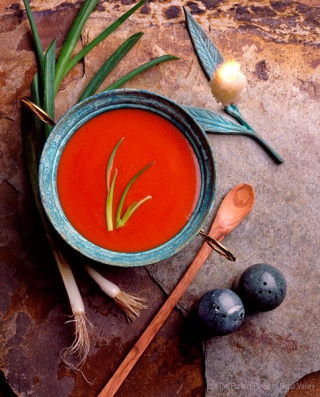
Turn up the Simmer on Soup
31 October 2017Who says soup has to be boring? Soup can be simple or complex, sexy or soulful, a staple for a pre-meal offering or the main attraction.
By Lisa Parrish, GMC Editor
 Soups, although popular year-around, begin to come to the front of consumers’ minds when choosing foods during the cooler months. In addition to being warm, soups are often considered healthy, economical and with all the possible flavor combinations, soups can satisfy the most sophisticated palate.
Soups, although popular year-around, begin to come to the front of consumers’ minds when choosing foods during the cooler months. In addition to being warm, soups are often considered healthy, economical and with all the possible flavor combinations, soups can satisfy the most sophisticated palate.
People who choose soup, commonly do so because it is perceived as being a healthy option, making it especially attractive to the many consumers who are actively watching what they eat. A 2016 Pew Research Center found that roughly seven-in-10 adults or 72 percent say that healthy eating habits are very important. Offering a variety of soups, specifically ones that incorporate vegetables and lean meats, will appeal to peoples’ desire to eat healthier.
Variety may be the spice of life, but it’s also key to piquing consumers’ interest in a hot bowl of goodness. A greater range of soups appeal to more consumers and also keeps them from becoming bored with the same choices. According to Gordon Food Service, the top 250 full-service chain restaurants menu an average of three varieties of soup.
There are soups and then there are signature soups. Often perceived as a specialty item by customers, signature soups can be created from a time-honored recipe or have a special flavor that ties in specifically to the chef or establishment. Signature soups can be made from scratch or begun with a prepared soup where chefs incorporate additional spices and ingredients. And by creating a great-tasting signature soup, chefs increase soup menu varieties.
Soups can fall into varietal styles such as broth-based, purees, cream-based, and chili. Each of these varieties can be categorized as vegetable only or vegetable and protein. For instance, chefs can make vegetarian chili with beans or beef chili with corn and tomatoes.
Purees and broth-based soups feature vegetables as their main flavoring ingredient. But buy pureeing the vegetable, soups take on a silky, creamy and smooth mouth feel. Puréed soups have the added benefit of easing digestion and also creating a very convenient dish. Perfect Puree of Napa suggests purees of cauliflower and roasted red pepper or roasted red pepper and leek in one-pot applications that are packed with antioxidants and have fire-roasted flavors.
Another puree option is fruit purees for cold soup applications. They are typically made with fresh fruits that are processed quickly by the body, leaving vitamins and nutrients intact to provide healthy fuel. Soups also help replenish the fluids lost through sweating and help rehydrate the body. Dole Foodservice offers frozen fruit purees that can be the base of a cold soup options without incorporating artificial flavors, high fructose corn syrup, preservatives and genetically modified or engineered ingredients.
Prepared soups can also be used for additional applications for increased flexibility in the kitchen. In addition to using soup as a base for dips, sauces, and spreads, prepared soup can also be a unique ingredient in creating main entrées. Use cheese soup as the base for a signature queso or create a unique pasta sauce using lobster bisque. Chefs can add tomatoes and onions to black bean soup to create a filling for quesadillas. Finding alternative uses for soups also helps reduce product waste.
Storage options alone should not determine which type of prepared soup to use, but storage should be considered as an indication of which soups might work best. Refrigerated soup has a shorter shelf life than frozen, but chefs can usually extend shelf life by freezing.
Photos courtesy of Perfect Puree of Napa.
